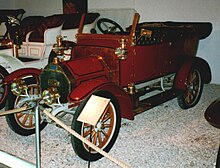



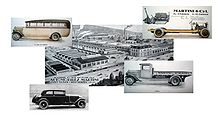

Martini was a pioneer Swiss automobile manufacturer, in operation 1897 to 1934.






Martini was a pioneer Swiss automobile manufacturer, in operation 1897 to 1934.
In 1897, Swiss businessman Adolf von Martini, son of Friedrich von Martini, the inventor of the action used in the Martini–Henry rifle, built an experimental rear-engined car. He followed this with V4 cars of 10 hp (7.5 kW) and 16 hp (12 kW) in 1902. Since Swiss cantons were unusually hostile to cars, [1] the company had to rely more than most on exports, and demand from abroad proved sufficient to justify building a factory in Saint-Blaise in 1904; von Martini relied on a licence from Rochet-Schneider of France, using an armored wood chassis and mechanically operated valves.
Promptly, his British sales agent, Captain H. H. P. Deasy, set off in a 16 hp on a 2,000-mile (3,200 km) trek through the Alps, which followed his earlier stunt of driving a cog-wheeled Martini up a mountain railway; his praise in both cases was effusive. By 1906, Deasy was the sole salesman. That summer, with a 20 hp and a four-cylinder 40 hp available, Deasy made an ill-advised challenge to Rolls-Royce (which had a six-cylinder engine); Deasy, and (more importantly) Martini lost the 4,000-mile (6,400 km) "Battle of the Cylinders".
For 1907, there was also a chain driven 28 hp, and an entry in the Kaiserpreis rally, where the marque placed thirteenth and fifteenth. In 1908, showing the rapid pace of change, shaft drive was standard, in 12 hp, 16 hp and 20 hp models (all still four-cylinder engines, however). That year's Coupe de Voiturettes saw 1086-cc (66 ci) inlet-over-exhaust SOHC-engined Martinis seventh, eighth, and tenth, enough for the team victory.
The racer was marketed as a 1909 road car, the 10/12, and new monobloc construction was standard across the line. Yet the engineers could not make up their minds; in 1910, they reverted to side valves, and in 1913 switched to sleeve valves for the 25/35. The marque's last racing attempt in 1913 used an overhead camshaft engine with four 85 x 132 mm cylinders, hemispherical combustion chambers and four valves per cylinder. It was known as the '15 Sport' and a regular competitor at hillclimbing events. [2]
The years leading up to the World War were Martini's best, with annual production hovering around 600 cars, placing the company at the head of the Swiss automobile industry. [3] While foreign manufacturers were already making inroads, the war years kept Martini in the black as they delivered large numbers of vehicles to the Swiss Army. [3]
The post-war recession, however, crippled Swiss exports including those of Martini. Martini was one of a very few manufacturers to restart production, with a mildly warmed over pre-war design as the TF 15/45 PS. [3] A conventional four-cylinder of 3.6 litres displacement, it was wholly outdated in spite of a high standard of finish, with sales beginning at a low pace and then steadily sinking. Swiss manufacturers, with only a tiny domestic market, had been heavily export-dependent but external markets vanished in the harsh economic climate of the early 1920s. In June 1924 the nearly bankrupt Martini company was taken over by the Steiger brothers of Burgrieden, Germany. [4] The Steigers relocated to Switzerland, having seen the writing on the wall for their German company which closed down in 1926, forcing the Steigers to sell their home to satisfy the creditors. [5] The old TF soldiered on until 1925, but at the 1926 Geneva Motor Show Walther Steiger was able to show the new Martini-Steiger FU six-cylinder car. [6] This had a side-valve engine of 3.1 litres and was a fully modern automobile albeit without any technical advances. It entered production in 1927, along with the larger (4.4 litres) FUS model. While sold as the "Martini Six" at home, the "Steiger" (meaning "Climber", suitably enough for a Swiss car) part of the name was emphasized in export markets where it was the "Steiger-Martini." Steiger's Alpine Chamois buck was incorporated into the logo and was also used as a hood ornament. [6]
The Martini Six, while of a mainstream design, maintained Martini's high quality and workmanship standards and was an accordingly expensive car. Only a few hundred were built from 1927 until 1930, with the lion's share being sold at home in Switzerland. [7] The FU and the FUG engine shared a 120 mm (4.7 in), with a 74 mm (2.9 in) or an 84 mm (3.3 in) bore for the smaller and larger engine, respectively. Power outputs were 55 and 90 PS (40 and 66 kW) at 3000 and 3200 rpm. [6] The larger version proved considerably more popular and a series of revisions beginning in 1929 was mainly applied to the 4.4-litre version. The updated versions were sold as the Martini FUS and FN (and the smaller-engined FUN) with various improvements. Already in 1929 the updated FUS gained a four-speed gearbox, all-wheel brakes, and twin Zenith carburettors. [7] In 1931 the FUN and FN versions were discontinued, but next year's NF model was a modernized version of the earlier FN.
During the Great Depression it quickly became clear to Martini that their existing six-cylinder cars were too expensive for the times. Accordingly, Martini signed a contract with Wanderer in 1930 to license build their recently updated Wanderer W11 six-cylinder car, a lighter, smaller, and cheaper proposition. This was badged Martini KM but it did not sell as well as hoped, likely the result of being a rather heavy car with low peak power and a weak chassis. The KM differed from the W11 only in minor details such as a marginally longer wheelbase and larger tread, altered gearing, and by using Scintilla lights and magneto rather than Bosch ones. [7] The KM was likely intended only as a stopgap vehicle, as Walther Steiger had charged his old friend and engineer Paul Henze to develop an all-new front-wheel-drive car. This design, however, barely even reached the drawing boards as a result of the financial state of Martini - and that of the world. [7]
The larger FUS was built alongside the KM until the smaller car was discontinued in 1932. This was also when the updated 4.4-liter NF was presented. Derived from the FU it offered many technological advances such as a worm drive rear axle, a fully synchronized gearbox, hydraulic shock absorbers and hydraulic four-wheel brakes, as well as modern styling thanks to a low-slung chassis. This, however, was not enough to save the company. The 95 PS (70 kW) NF soldiered on until 1934 before just fading away, Martini with it.
The Martini company also manufactured bookbinding machinery. They were purchased by Hans Müller and the company was renamed Müller Martini. The original factory is still in use today, and has a 1917 Martini car on display in the lobby of their Bookbinding Academy.

Panhard was a French motor vehicle manufacturer that began as one of the first makers of automobiles. It was a manufacturer of light tactical and military vehicles. Its final incarnation, now owned by Renault Trucks Defense, was formed by the acquisition of Panhard by Auverland in 2005, and then by Renault in 2012. In 2018 Renault Trucks Defense, ACMAT and Panhard combined under a single brand, Arquus.
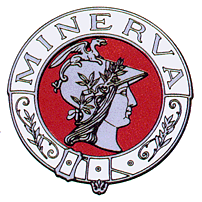
Minerva was a Belgian firm active from 1902 to 1938 which was a prominent manufacturer of luxury automobiles. The company became defunct in 1956.

Unic was a French manufacturer founded in 1905, and active as an automobile producer until July 1938. After this the company continued to produce commercial vehicles, retaining its independence for a further fourteen years before being purchased in 1952 by Henri Pigozzi, who was keen to develop Unic as a commercial vehicle arm of the then flourishing Simca business.

The Nissan Pintara is a compact automobile that was manufactured by Nissan Motor Australia from 1986 until 1992.

Delage was a French luxury automobile and racecar company founded in 1905 by Louis Delâge in Levallois-Perret near Paris; it was acquired by Delahaye in 1935 and ceased operation in 1953.
The Lanchester Motor Company Limited was a car manufacturer located until early 1931 at Armourer Mills, Montgomery Street, Sparkbrook, Birmingham, and afterwards at Sandy Lane, Coventry England. The marque has been unused since the last Lanchester was produced in 1955. The Lanchester Motor Company Limited is still registered as an active company and accounts are filed each year, although as of 2014 it is marked as "non-trading".

Wolseley Motors Limited was a British motor vehicle manufacturer founded in early 1901 by the Vickers armaments combine in conjunction with Herbert Austin. It initially made a full range, topped by large luxury cars, and dominated the market in the Edwardian era. The Vickers brothers died and, without their guidance, Wolseley expanded rapidly after the war, manufacturing 12,000 cars in 1921, and remained the biggest motor manufacturer in Britain.

The Siddeley-Deasy Motor Car Company Limited was a British automobile, aero engine and aircraft company based in Coventry in the early 20th century. It was central to the formation, by merger and buy-out, of the later Armstrong Siddeley Motor and Armstrong Whitworth Aircraft companies.
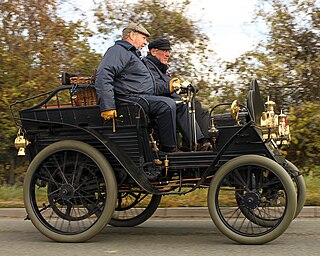
The Mors automobile factory was an early French car manufacturer. It was one of the first to take part in automobile racing, beginning in 1897, due to the belief of the company founder, Émile Mors, in racing's technical and promotional benefits. By the turn of the century, automobile racing had become largely a contest between Mors and Panhard et Levassor.

Albion Motors was a Scottish automobile and commercial vehicle manufacturer.
Hansa-Automobil Gesellschaft m.b.H was a German car brand established in 1905, which in 1914 was merged with Norddeutsche Automobil und Motoren AG (NAMAG) into Hansa-Lloyd-Werke A.G.. From 1929 to 1931 it was taken over by the Borgward group. Hansa was based in the Bremen suburb of Hastedt.

Lorraine-Dietrich was a French automobile and aircraft engine manufacturer from 1896 until 1935, created when railway locomotive manufacturer Société Lorraine des Anciens Etablissements de Dietrich et Cie de Lunéville branched into the manufacture of automobiles. The Franco-Prussian War divided the company's manufacturing capacity, one plant in Niederbronn-les-Bains, Alsace, the other in Lunéville, Lorraine.

Impéria Automobiles was a Belgian manufacturer of automobiles, active between 1906 and 1948. Its factory in Nessonvaux, Liège had a rooftop test track since 1928.
Buchet was a French motorcycle and automobile manufacturer between 1911 and 1930.

The Steiger company was founded in 1914 as Maschinenfabrik Walther Steiger & Co. by the Swiss engineer Walther Steiger (1881–1943) in Burgrieden near Ulm, Germany. In 1921 it became a limited company. During its short life the firm produced circa 3,000 vehicles.

Rolland-Pilain was a French car maker formally established on 4 November 1905 at 95, rue Victor-Hugo in Tours by François Rolland and Émile Pilain.

In 2015 Spain produced 2.7 million cars which made it the 8th largest automobile producer country in the world and the 2nd largest car manufacturer in Europe after Germany. The forecast as of 2016 was to produce a total of 2.8 million vehicles from which about 80% is for export. During the first half of 2016, with exports valued over 24 billion euros over that period, the automotive industry accounted for 18.9% of the total Spanish exports.

The Nissan Junior was a series of medium-sized pickup trucks built from 1956 until 1982. It was introduced to fill the gap between the smaller, Datsun Bluebird based Datsun Truck, and heavier load capacity Nissans under the Nissan Diesel brand, like the 80-series trucks. After the merger with Prince Motor Company, the Junior and the Prince Miler were combined, sharing most of the characteristics, with the Junior sold at Nissan Bluebird Store Japanese dealerships, and the Miler sold at Nissan Prince Store until 1970.
The Belgian Fabrique Nationale d’Armes de Guerre(National Manufacturer of War Weapons) company, also sometimes known as Fabrique Nationale de Herstal (National Manufacturer at Herstal), but better known simply as "FN" or "Fabrique Nationale" was founded at Herstal on the edge of Liège in 1889. As well as weapons, it was for many years a manufacturer of motorbikes and of automobiles.
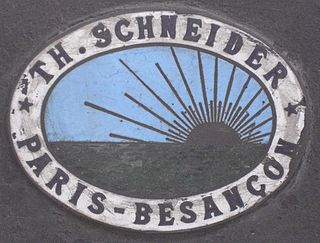
Th. Schneider was a French automobile manufacturer.